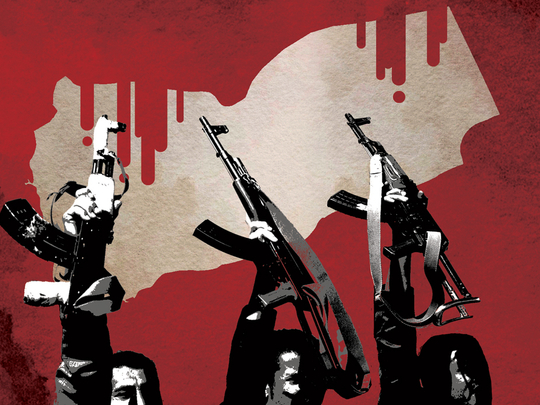
International media circulated an image of a young Yemeni girl standing in front of a large sticker in a main street in Sana’a, which quoted a part of a prophetic Hadith, “The blood of a Muslim is inviolable for a Muslim”. The image aimed to arouse sympathy in the international community, spreading a message that Sana’a inhabitants were under attack led by the coalition forces.
A realistic look at the Yemeni situation disproves this view and confirms the contrast between the image and Al Houthi actions across the country such as alleged war crimes, violence, arrest of opponents, prosecution of journalists and sectarianism inside and outside Sana’a.
If the Al Houthis claim to be advocates of peace, their actions must reflect that, because the facts on the ground send a completely different message.
There is a clear split in the international community in interpreting what is happening in Yemen. This has led to contradictory political positions. Some international entities stand against the coalition, painting Al Houthis as the victims. Historical tracking of the Al Houthi movement in Yemen since the initiation of its religious ideology in the late 1980s, its transition to a political party in the 1990s and its appearance as an armed political organisation, emphasises its goals in the promotion of its doctrine, which combines two Shia sects (Zaidi and Twelver), to execute its political agenda inside Yemen. That was reflected in several Al Houthi resolutions, such as the constitutional declaration, the creation of a tribal elders council and all other decisions issued by Al Houthi since their intrusion of Sana’a on September 21, 2014. This confirms that the movement was aiming to control the country but failed to act as a politically organised unit and transferred gradually into an armed militia.
Psychological and political analyses of Al Houthi actions and their methods and techniques confirm they have a severe tendency towards violence and lack remorse or conscience, whether towards their soldiers or the Yemeni people in general.
The doctrine of violence adopted by Al Houthis may be similar in its military and political essence to that adopted by radical Islamist extremists, whether Sunna or Shia.
Al Houthis practice violence even with their followers. They are not concerned with checking on their dead soldiers or following up on the scale of their human losses.
Their actions and statements are positively acknowledged by similar violent militias in the region. This confirms suspicious and illegal ties between these extremist militias, which is a key factor in the spread of chaos and instability not just in the region but in the whole world.
The coalition currently has the upper hand in the Yemen war, though it is important from political and military perspectives to underline the battles in Maarab, for the coalition and the Yemeni resistance, as a transition in Yemen warfare. It is a second phase in facing Al Houthi rebels and troops loyal to former Yemen president Ali Abdullah Saleh, and may require a radical change in plans, leadership and the exchange of roles between the coalition and the resistance on the way to Sana’a.
The long history of chaos, turmoil and conflict over three decades between southern and northern Yemen after the establishment of unity in 1990, confirms the dissimilarity in the manner of leadership, people’s future perspectives, the management of economic activities, cultural identity and social tribal incubators.
So what could meet the needs of the southern provinces, especially with respect to military and security aspects, might not succeed in making an impact in the northern provinces in the context of confrontation with Al Houthi and Saleh troops.
The incident at Safer in Maarab that claimed the lives of more than 70 coalition soldiers, and a similar incident in Mukeiras after brigade Al Majed turned against legitimacy and killed more than 50 fighters from the southern resistance, revealed that the rebels and their allies are adopting certain techniques in their confrontation with the coalition. These include the exploitation of members of the legitimate Yemeni army to strike at the coalition; the implementation of rebel sleeper cells inside cities and camps to act as invisible intelligence and provide them with the coordinates of the sites and troops’ positions; and the third element is the exploitation of some northern provinces, to help support their front.
Although Al Houthi and Saleh troops face considerable rejection in the northern provinces, which have high rates of population in areas such as Taiz, Ibb and Hodeidah, they still have religious, political and economic domination over other northern provinces, which are considered hot-beds of support.
Whether during military disputes or in the process of reaching a possible peace agreement, the coalition should be careful to ensure that these obstacles do not pose a threat to the future security and stability of Yemen.
It is important to bring an end to the battles. Chaos breeds militias such as Al Houthi and Saleh’s mercenaries, where they practice the authority of the tribes away from the institutions of the modern state. They look to gain profit from the black market, they enhance sectarian and tribal divisions in Yemeni society and they adopt illegal practices to encourage young Yemenis to join them (soldier have the right to seize and confiscate properties). The life of their soldiers and the future of the Yemeni people are the least of their concern.
Haifa AlMaashi is a former professor at the University of Aden and a senior researcher in ‘b’huth’ (Dubai).










